

|
|
|
|
|---|---|---|
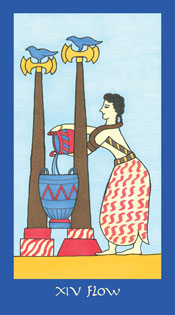
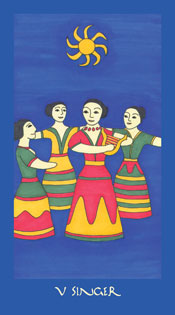
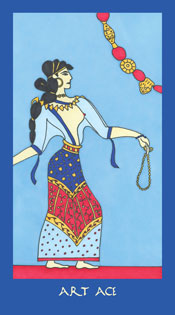
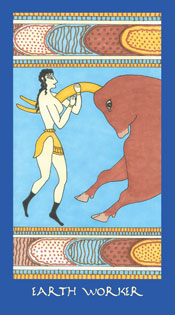
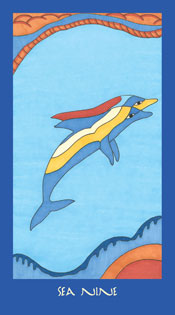
|
This is not a review in the traditional sense. I won’t talk about the card stock, how they feel in my hands or how easy they are to shuffle. Others can focus on these aspects. What I write about below is my personal
experience as I explore this new deck of cards.
I confess I know very little about the Minoan civilisation so there is a need, before I unlock the cards from their protective cellophane wrap, to acquire some background information. I don’t have to go far. The outline offered up in the accompanying booklet is more than satisfactory; a slightly larger and thankfully more useful text than what is often found in a traditional ‘little white book’. As I do my first pass through the deck I immediately notice the colour. Bright. Vivid. Strong. I hope Ellen is happy with the reproduction and that the colours shown are indeed as she intended. They look great here. As a creative person the visual cues I get when I read cards are very important to me. What I ‘see’ creatively is just as important as what I ‘think’, or ‘know’, or ‘feel’. For the sake of this ‘review’ I want to go through each card methodically, one by one. Taking time over individual cards. But try as I might, this way of doing things doesn’t last long. There is an urge to jump ahead. I flick through the cards and as a result begin to take in a whole lot of things at once. I note that the titles on some of the cards are what I would expect to see in a tarot deck. The Star, Moon, and Sun. But most of the cards have been renamed. Some are at first glance easy for me to connect. XVI for example is labelled Shipwreck. As I pause looking at the image, I notice the essence of The Tower, as I know it, is definitely there. XIV Flow replaces Temperance, and II Oracle replaces the High Priestess. Others however are not so obvious. V for example becomes Singer. This will require further exploration. I am distracted. It’s a reflection on me though, not the cards. I can’t resist the urge any longer. I need to mix up the deck. I just can’t immerse myself in the essence of these cards in a linear fashion. It is about now that I suspect I might regret not taking more time to view the deck in a more orderly fashion, but I go ahead anyway and mix up the cards. In honour of the 600 years that ‘the great Minoan palaces ruled the island of Crete’ and the 600 years of ‘peaceful development prior’, I shuffle the cards for six minutes. As I am caught up in this ritualistic rhythm, I make the decision that the first card to ‘spring’ from the pack will represent my connection with the deck. Enter Art Mistress. I am immediately disoriented. Is it because I have not taken the time to really consider the structure of the deck that I am caught off guard? I recognise Art Mistress to be a ‘court card’ and the word Art suggests she could be from the suit of ‘wands’. But Mistress, is that the ‘king’ or the ‘queen’? I am looking for something familiar to pin my existing knowledge on and it isn’t there. I have to remind myself: in this deck Art Mistress isn’t about kings or queens or the suit of wands. She is simply Art Mistress. She exists in her own right. She has new meaning. This, I think, is a challenge faced with a deck that introduces new identities into an existing structure or framework. On the surface it is more or less suggested that the cards represent something that is familiar, but of course this is not necessarily the case. It momentarily floors this user. I like her. This Art Mistress. She sits comfortably on her throne. She holds a large vessel raised high in front of her as if offering a toast. ‘Yiamas!’ she says. She is me, I am she. She raises her vessel perhaps in acknowledgement and appreciation before she indulges in the beverage contained within. What I like too is the fantastical creature at her service. Arms outstretched holding a jug at the ready. Ready to pour her another glass. There is more. As I refer to the booklet and consult the text that accompanies this card I smile to myself at the message she brings. ‘Check out alternatives to the standard programme.’ As I focus on individual cards I am again momentarily disoriented. Sky Nine sits before me but I don’t see nine of anything. I see three birds, six (pottery?) balls, and three – I presume stone – pillars. Where is the connection with nine? I reference the text and discover ‘there are no symbols to be counted in the images, nor is the number of the figures an indication of the card’s designation.’ Ellen wanted to stay true to the artworks she was sourcing her imagery from, thus they were ‘not adulterated’. I also discover that ‘the images are assigned to the cards by the correspondence of their energies alone’. She goes on to say that there is no ‘progression of quantity, but rather [the images] stand for the selected qualities, no one of which is greater than another.’ I am curious here as to why then a numerical sequence has been assigned. Many readers use the numerical value of the cards as prompts and would by default use a progression. Again that existing framework or structure of a traditional tarot is challenged. But Ellen does in fact assign the numbers meaning. The Ace, for example, is individuality; the four, practicality; and the eight, power. I wonder how I would have felt if, rather than Art Ten, the card was referred to as Art Transformation. Or Sky Seven was Sky Spirituality. As it stands I have to ‘see’ a number and instantly remember a pre-assigned concept. To get my mind to filter this new information and recalibrate takes effort. This begs the question, when is a tarot deck not a tarot deck? I look up the meaning of the word tarot in the Oxford dictionary. It reads: Playing cards, traditionally a pack of 78 with five suits, used for fortune-telling and in certain games. The suits are typically swords, cups, coins (or pentacles), batons (or wands) and a permanent suit of trumps. I frown. I don’t think even Oxford have got it right. ‘Traditionally used for fortune-telling’. Well, not originally. Not in the 1400s. But based on Oxford’s meaning, and given this is probably what most of the world thinks, would it be more fitting perhaps to refer to a deck of cards that doesn’t fully meet these criteria as say, tarotesque? It’s just a thought. Art Mistress reminds me again, ‘check out alternatives to the standard programme.’ Now I am keen to discover whether or not this is a deck I can actually ‘read’ with. In the days prior to these cards arriving in my letterbox the world was subjected to the horror of an unhinged attention seeker in Sydney, Australia, who, in his deranged and twisted existence, was to drastically alter forever the lives of 17 individuals, their families, friends, a nation and the world itself. Australia is not where I live, but it is close enough to home to have this event occupy my thoughts as if it might be. I use this as the basis for a three-card reading. I don’t assign positions as I normally would. Perhaps it’s a little shortsighted given that this ‘assignment’ helps give cards context in a reading. But, being unfamiliar with the deck, I want to approach it from two levels initially. For the cards to ‘work’ for me, first and foremost they must resonate visually, given that this is a key attribute of my reading style. Secondly, I want to glean insight from the text Ellen supplies in her accompanying booklet. I pull three cards. The visuals work. At first the prompts I receive feel almost like bullet points and appear simplistic. But in some ways that is expected. The artwork, being thousands of years old, is in many ways just that: simplistic. As I consider the imagery further, much deeper meanings begin to flesh out. Suddenly my head is filled with a flood of information. It resonates. It makes sense. For further clarity I turn to the appropriate page of the booklet and receive the following message: ‘Bravery is called for. Go on despite your fear. Do not be intimidated; the thoughts of another person cannot weaken you if you do not let them in. A show of confidence will improve the situation.’ I raise my glass to Art Mistress. So, what are my overall thoughts about this deck? I think anyone can use it as a stand-alone deck. The background information and explanations given in the accompanying booklet have been set out in a way that makes for clear referencing. Reading the cards in a more traditional tarot sense, however, could be problematic for a beginner to tarot. The fact Ellen assigns the differences she does within the structure of the deck may cause some confusion initially. Is it a deck I would use with clients? Probably not. But only because delving deep into the intricacies of a lost civilisation – and exploring the insight that comes from the artworks it has left behind – would be impossible to achieve within the short timeframe one normally has with a querent. The collection of imagery and the background information Ellen shares with us in the Minoan Tarot provokes thought, and lends itself to the deck being used in a contemplative or meditative way. And readings like this deserve not to be rushed. Ellen, I admire and wholeheartedly appreciate the obvious passion you have for both the Minoans and the tarot. In bringing them together you remind me that such a process can result in the sum being greater than its parts. And, from the Mistress of Imagination I have learned that, ‘creations come alive when there is magic in the world’. Lyn Howarth-Olds Auckland, New Zealand
|
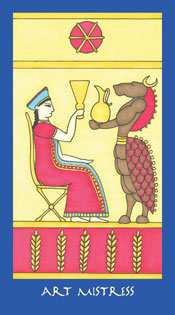
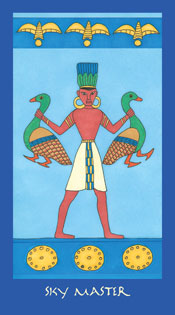
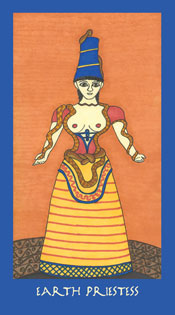
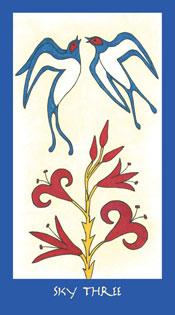
|
|
|
Minoan Tarot is copyright protected. Card images may be used on blogs/websites as 'Card of the Day' endeavors or for review purposes but must contain the website along with Minoan Tarot by Ellen Lorenzi-Prince. The images are not to form part of written teaching materials or otherwise be used without prior consent from the artist. | |
|
|
Home · Tarot of the Crone · Dark Goddess Tarot · Minoan Tarot · Arts & Artifacts · Contact | |
|
This site designed & maintained by Arnell's Art |